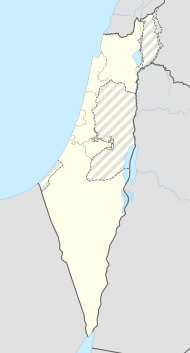Sha'ar HaGolan
| Sha'ar HaGolan | ||
|---|---|---|

|
||
| Dining room in Kibbutz Sha'ar-Hagolan | ||
| Basic data | ||
| hebrew : | שַׁעַר הַגּוֹלָן | |
| State : |
|
|
| District : | North | |
| Founded : | March 21, 1937 | |
| Coordinates : | 32 ° 41 ' N , 35 ° 36' E | |
| Height : | 195 m below sea level | |
| Residents : | 552 (as of: 2018) | |
| Community code : | 0264 | |
| Time zone : | UTC + 2 | |
| Postal code : | 1514500 | |
| Community type: | Kibbutz | |
| Website : | ||
|
|
||
Sha'ar HaGolan ( Hebrew שַׁעַר הַגּוֹלָן Schaʿar ha-Gōlan , German 'Gate of the Golan' ), is a kibbutz at the foot of the Golan Heights in the Jordan Valley in northeast Israel. It is located south of the Sea of Galilee , less than 1 km from the border with Jordan and belongs to the regional association Emek ha-Jarden . In 2018 it had 552 inhabitants.
history
Schaʿar HaGolan was founded on March 21, 1937 by members of the Hashomer Hatzair youth movement from Czechoslovakia and Poland . The founders met in Rishon LeZion in 1930 and formed a team. They were called "ʿEin HaQore" until 1937 when they founded the kibbutz as a tower-and-palisade settlement . During the fighting in the Arab-Israeli War of 1948, the defenders of Shaar ha-Golan withdrew after air raids and fire. The kibbutzim were captured and briefly held by the Syrian army. During this time the place was looted and burned down. Although the members soon returned, they were stigmatized as cowards and it was only after nearly 60 years that rehabilitation came in the form of declassified military files.
economy
The main source of income for the kibbutz is a plastics factory. Agricultural products are bananas, avocados and watermelons, plus a herd of dairy cows. For the tourism industry, one of the attractions is the Museum of Yarmuk Culture with prehistoric Neolithic finds discovered on the banks of the Yarmuk River. Founded in the 1950s, it was the first museum of prehistory in Israel.
archeology
The kibbutzniks found numerous prehistoric artefacts in 1943 when setting up fish ponds in their fields on the banks of the Yarmuk . A first excavation under M. Stekelis from the Hebrew University of Jerusalem brought to light evidence of a ceramic Neolithic settlement between 1948 and 1962 . Among them were the oldest ceramic cooking pots found in Israel. The previously unknown culture was named Yarmuk culture after the location of the site .
From 1989 to 2004, Yosef Garfinkel continued the excavations. During eleven excavation campaigns, around 3,000 square meters were opened on a total of five areas. The buildings, streets and squares of a large Neolithic village dating from 5,500 to 5,000 BC were uncovered. Was dated. The discovery brought extensive knowledge about the beginning of sedentary life in the Levant.
Web links
- Official website (Hebrew)
Individual evidence
- ↑ אוכלוסייה ביישובים 2018 (population of the settlements 2018). (XLSX; 0.13 MB) Israel Central Bureau of Statistics , August 25, 2019, accessed May 11, 2020 .
- ↑ Postal code ZIP code Shaar HaGolan. Retrieved October 25, 2018 .
- ^ Zionist mythology destroys its children Haaretz, April 6, 2006
- ↑ Pexgol
- ^ Archaeological Excavations at Shaʿar Hagolan - A Neolithic Art Center in the Jordan Valley, Israel Hebrew University of Jerusalem
- ^ Jewish virtual library
- ^ Yosef Garfinkel, David Ben-Shlomo, Nimrod Marom: Sha'ar Hagolan: A major Pottery Neolithic settlement and artistic center in the Jordan Valley Eurasian Prehistory, 8 (1–2): 97–143.

